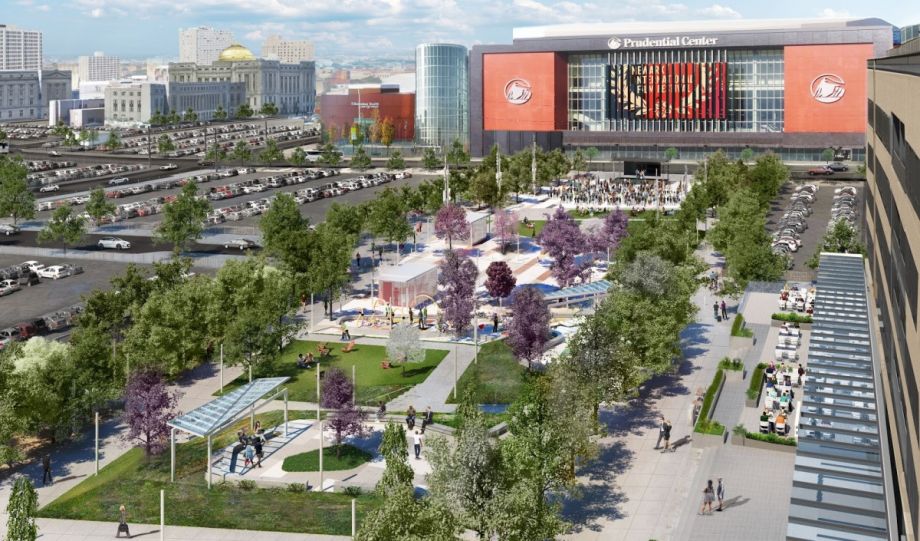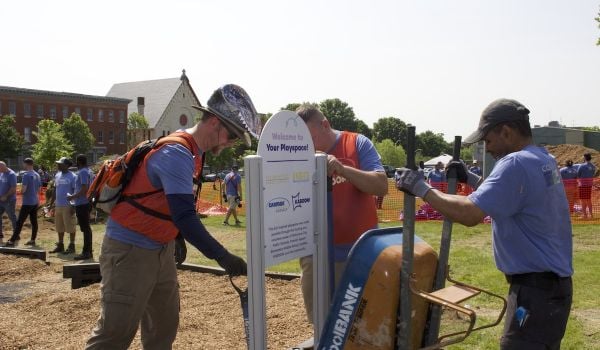After more than a decade of planning, Newark has opened its newest downtown park, Mulberry Commons. The $10-million project turns three acres of former parking lots in front of the Prudential Center arena into an outdoor public space linking Newark Penn Station to the arena with landscaping, seating, and kids’ attractions such as a slide and a splash park.
City documents call Mulberry Commons a “new center of gravity” downtown and a catalyst for unlocking up to $400 million in economic impact.
“What you see is a park, but what you don’t see is all of the development that will take place because of this park,” Mayor Ras Baraka said at the park’s ribbon-cutting. “You don’t see the residential, commercial, restaurants, retail, and all of the activity that’s going to take place down here.”
With this opening, Mulberry Commons joins Newark’s other downtown parks in a renaissance of sorts. Military Park, one of the city’s original three parks, was renovated in 2014. Riverfront Park, one of the city’s newer parks, was completed in 2013. Lincoln Park, another of the city’s original parks, has been transformed “from a passive park to a place where people can gather,” says Anthony Smith, executive director of the Lincoln Park Coast Cultural District. The nonprofit has been working to revitalize the neighborhood (including the park) with community support for the past 15 years. Now Lincoln Park is the neighborhood’s “crown jewel” and boasts an annual music festival that draws tens of thousands of people and a nod from Vogue.
“People are moving back to the city, people want to be in the city. They want — why go to New York when you can do it in Newark?” Smith says. “The growth and momentum happening in our city have catapulted the importance of having a walkable downtown…That’s the movement and I think it’s amazing.”
Patrick Conlon is the owner of Newark Community Cycling Center, perched right on the edge of Military Park. The center — a community bike shop that also teaches cycling skills and promotes cycling in Newark — also runs events in the park, which he says “has become a central hub within the city.”
Backers hope Mulberry Commons will achieve the same. It’s part of a planned larger 22-acre development that includes offices and homes. A second phase of the park buildout will include a pedestrian bridge linking the park with Penn Station and the Ironbound, the neighborhood just to the east.
That’s a development many look forward to. Drew Curtis, senior equitable development manager for Ironbound Community Corporation, says the second phase “will help bridge the divide, I think, between Ironbound and the rest of Newark, because Ironbound is literally cut off from the rest of Newark by the Amtrak corridor. And it’s a physical divide, but also almost more a mental divide, an emotional divide. It kind of walls off Ironbound. So this will help, once the second phase of Mulberry Commons opens, there will be that direct connection too.”
But what about the park itself? Who will use it?
It’s not just “build it and they will come,” cautions Smith, who has followed the development of Mulberry Commons with interest. “It’s more than just the park, it’s the relationship of the park to the community,” Smith says. To build Lincoln Park into a place that locals consider “their” park took years of work.
Smith highlights his organization’s work engaging stakeholders and residents through monthly meetings and focus groups about issues in the community. “When you have a connection, you can then have a call to action with the same people you’re developing relationships with,” he says.
Smith adds that after those years of work, “Lincoln Park has its own identity, it’s own audience. We shouldn’t be competing with [other parks].” He wishes there was a citywide clearinghouse where all of Newark’s parks could share their programming, so that the whole city becomes a destination.
Curtis concurs. On a recent weekend, Riverfront Park and Military Park — 20 minutes apart on foot — were each having events. “So there are already core parks in Newark that get a lot of use too, so how do you find that right balance?”
On the other hand, done right, parks working together could spark something new. Smith is planning to join forces with other organizations and partners around the city to grow Lincoln Park’s music festival “to create our own SXSW or Coachella here.” Part of that could mean collaborating with other venues. “Not only will our park be a place to perform, but Mulberry Commons and Military Park — you can just imagine all these places activated…. This [festival] touches so many communities, we can have so many stages…. I think each park has its own character and offerings, and if we can all understand that there’s something unique about each location, that means we’ll have people moving throughout the city to see the wonderful things that are being programmed.”
Additional reporting by Janine White and Natalia Rommen. EDITOR’S NOTE: This article has been updated to correct Drew Curtis’s title.

Rachel Kaufman is Next City's senior editor, responsible for our daily journalism. She was a longtime Next City freelance writer and editor before coming on staff full-time. She has covered transportation, sustainability, science and tech. Her writing has appeared in Inc., National Geographic News, Scientific American and other outlets.
Follow Rachel .(JavaScript must be enabled to view this email address)
















